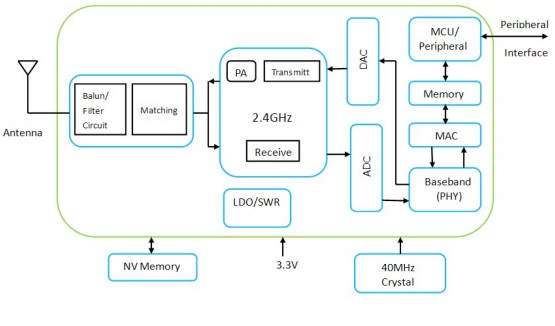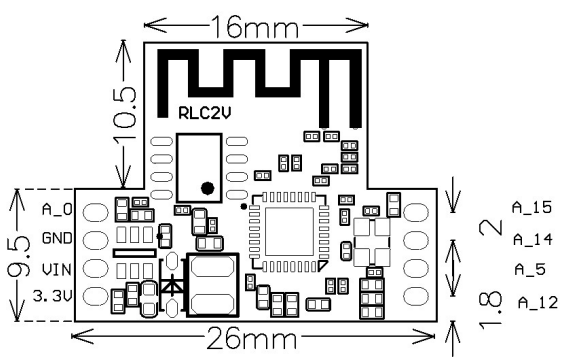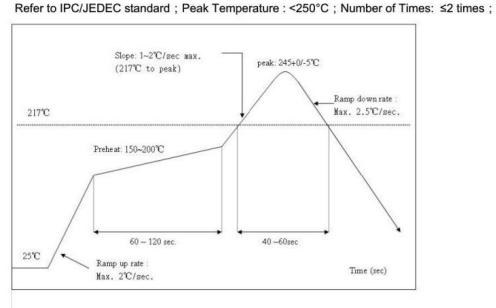RLC2V Module Datasheet
Last Updated on : 2021-06-09 04:13:29download
RLC2V is a low power-consuming built-in Wi-Fi module developed by Hangzhou Tuya Information Technology Co., Ltd. It consists of a highly integrated radio frequency chip (RTL8710BX) and an external flash chip, with a built-in Wi-Fi network protocol stack and robust library functions.
Overview
RLC2V also contains a low power-consuming ARM CM4F, a WLAN MAC, a 1T1R WLAN, and the maximum basic frequency of 62.5 MHz, and is embedded with a 256 KB SRAM, a 2 MB flash, and robust peripheral resources.
RLC2V is an RTOS platform that integrates all the function libraries of the Wi-Fi MAC and TCP/IP protocols. You can develop built-in Wi-Fi products as required.
The schematic diagram of RLC2V:

Features
Built-in low power-consuming 32-bit CPU functioning as an application processor
-
Basic frequency: 62.5 MHz
-
Working voltage: 5 V to 38 V (16 V to 38 V by default)
-
Peripherals: five GPIOs
-
Wi-Fi connectivity
- 802.11 b/g/n20/n40
- Channels 1 to 14@2.4 GHz
- WPA/WPA2 security mode
- Up to +20 dBm output power in 802.11b mode
- SmartConfig mode (for Android and iOS devices)
- Onboard PCB antenna
- Passing the CE, FCC, and SRRC certification
- Working temperature: –20°C to +105°C
Major application fields
- Intelligent building
- Intelligent home and household appliances
- Healthcare
- Industrial wireless control
- Baby monitor
- Network camera
- Intelligent bus
Module interfaces
Dimensions and pin layout
RLC2V provides two rows of pins (2 x 4) with a distance of 2.0 mm between every two pins.
RLC2V dimensions: 26 mm (W) x 20 mm (L) x 3.5 mm (H).

Pin definition
| No. | Symbol | I/O type | Function |
|---|---|---|---|
| 1 | GPIOA_0 | I/O | GPIOA_0, which cannot be pulled up during power-on and can be configured after power-on. It is used for hardware PWM. |
| 2 | GND | P | Power supply reference ground pin |
| 3 | VIN | P | Power supply input |
| 4 | 3.3V | P | Power supply output |
| 5 | GPIOA_12 | I/O | GPIOA_12, used for hardware PWM |
| 6 | GPIOA_5 | I/O | GPIOA_5, used for hardware PWM |
| 7 | GPIOA_14 | I/O | GPIOA_14, used for hardware PWM |
| 8 | GPIOA_15 | I/O | GPIOA_15, used for hardware PWM |
Note: P indicates power-supply pins and I/O indicates input/output pins.
Electrical parameters
Absolute electrical parameters
Absolute parameters:
| Parameter | Description | Minimum value | Maximum value | Unit |
|---|---|---|---|---|
| Ts | Storage temperature | –40 | 125 | °C |
| VIN | Power supply voltage | –0.3 | 40 | V |
| Static electricity voltage (human model) | TAMB – 25°C | - | 2 | kV |
| Static electricity voltage (machine model) | TAMB – 25°C | - | 0.5 | kV |
Electrical conditions
Normal electrical conditions:
| Parameter | Description | Minimum value | Typical value | Maximum value | Unit |
|---|---|---|---|---|---|
| Ta | Working temperature | –20 | - | 105 | °C |
| VIN | Working voltage | 5 NOTE | - | 38 | V |
| VIL | I/O low-level input | –0.3 | - | 0.8 | V |
| VIH | I/O high-level input | 2.47 | - | 3.6 | V |
| VOL | I/O low-level output | - | - | 0.34 | V |
| VOH | I/O high-level output | 2.64 | - | 3.4 | V |
| Imax | I/O drive current | - | - | 16 | mA |
| Cpad | Input pin capacitance | - | 2 | - | pF |
NOTE: The minimum working voltage of the delivered module is 16 V by default. To change this value, specify it in order.
Wi-Fi TX power consumption
TX power during constant emission:
| Symbol | Mode | Rate | Typical value | Unit |
|---|---|---|---|---|
| IRF | 11b | 17 dBm | 287 | mA |
| IRF | 11 Mbit/s | 18 dBm | 295 | mA |
| IRF | 11g 54 Mbit/s | 15 dBm | 255 | mA |
| IRF | 11g 54 Mbit/s | 17.5 dBm | 267 | mA |
| IRF | 11n BW20 MCS7 | 13 dBm | 244 | mA |
| IRF | 11n BW20 MCS7 | 16.5 dBm | 257 | mA |
| IRF | 11n BW40 MCS7 | 13 dBm | 220 | mA |
| IRF | 11n BW40 MCS7 | 16.5 dBm | 230 | mA |
Wi-Fi RX power consumption
RX power during constant receiving:
| Symbol | Mode | Typical value | Unit |
|---|---|---|---|
| IRF | CPU sleep | 90 | mA |
| IRF | CPU active | 120 | mA |
Power consumption in working mode
Module working current:
| Working mode | Working status (Ta = 25°C) | Typical value | Maximum value | Unit |
|---|---|---|---|---|
| EZ mode | The module is in the EZ state and the Wi-Fi indicator fast flashes. | 115 | 125 | mA |
| Idle mode | The module is in the connected state and the Wi-Fi indicator is steady on. | 60 | 209 | mA |
| Working mode | The module is in the connected state and the Wi-Fi indicator is steady on. | 118 | 198 | mA |
| Disconnection mode | The module is in the disconnected state and the Wi-Fi indicator is steady off. | 34 | 192 | mA |
Note: The peak duration is about 5 µs.
The preceding parameter values vary depending on the firmware functions.
RF features
Basic RF features
Basic RF features:
| Parameter | Description |
|---|---|
| Frequency band | 2.400 GHz to 2.4835 GHz |
| Wi-Fi standard | IEEE 802.11b/g/n (channels 1 to 14) |
| Data transmission rate | 11b: 1, 2, 5.5, 11 (Mbit/s) 11g: 6, 9, 12, 18, 24, 36, 48, 54 (Mbit/s) 11n: HT20 MCS0 to MCS7 11n: HT40 MCS0 to MCS7 |
| Antenna type | PCB antenna |
Wi-Fi Output Performance
TX power during constant emission:
| Parameter | Minimum value | Typical value | Maximum value | Unit | |
|---|---|---|---|---|---|
| RF average output power, 802.11b CCK mode | 11 Mbit/s | - | 17.5 | - | dBm |
| RF average output power, 802.11g OFDM mode | 54 Mbit/s | - | 14.5 | - | dBm |
| RF average output power, 802.11n OFDM mode | MCS7 | - | 13.5 | - | dBm |
| Frequency error | –20 | - | 20 | ppm |
Wi-Fi RX Sensitivity
RX sensitivity:
| Parameter | Minimum value | Typical value | Maximum value | Unit | |
|---|---|---|---|---|---|
| PER < 8%, RX sensitivity, 802.11b CCK mode | 11 Mbit/s | - | –91 | - | dBm |
| PER < 10%, RX sensitivity, 802.11g OFDM mode | 54 Mbit/s | - | –75 | - | dBm |
| PER < 10%, RX sensitivity, 802.11n OFDM mode | MCS7 | - | –72 | - | dBm |
Antenna interference reduction
When using an onboard PCB antenna on a Wi-Fi module, make sure that the antenna on the module is at least 15 mm away from other metal parts to ensure optimal wireless performance.
Production
Storage conditions
Storage conditions of a delivered module are as follows:
-
The anti-moisture bag must be placed in an environment where the temperature is under 30°C and the relative humidity is under 85%.
-
The shelf life of a dry-packaged product is six months from the date when the product is packaged and sealed.
Note:
- Throughout the production process, each involved operator must wear an electrostatic ring.
- During the operation, strictly protect the module from water and strains.
Recommended oven temperature

Is this page helpful?
YesFeedbackIs this page helpful?
YesFeedback





